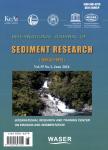An optimized use of limited ground based topographic data for river applications
An optimized use of limited ground based topographic data for river applications作者机构:Irstea UR River Ly centre de Lyon-Villeurbanne EDF R&D
出 版 物:《International Journal of Sediment Research》 (国际泥沙研究(英文版))
年 卷 期:2019年第34卷第3期
页 面:216-225页
核心收录:
学科分类:0709[理学-地质学] 0819[工学-矿业工程] 08[工学] 0818[工学-地质资源与地质工程] 0708[理学-地球物理学] 081501[工学-水文学及水资源] 0903[农学-农业资源与环境] 0815[工学-水利工程] 0816[工学-测绘科学与技术]
主 题:Digital Terrain Model Survey strategy Interpolation DTM error Gravel bar
摘 要:A prime requirement for hydrological applications, such as sediment budgeting or numerical modelling,is that produced Digital Terrain Models(DTMs) accurately represent the shape of landforms, especially for river reaches where data are not homogeneous. DTM error is a function of data point measurement accuracy and density and also of the field survey strategy when limited amounts of data will be *** paper aims to advance the importance of the field survey strategy for the specific, but common cases, where only limited topographic data will be available. This methodology is based on the idea that any feature can be properly described by a set of cross sections and breaklines describing both main and secondary directions of the flow. Then, a longitudinal linear interpolation can be applied to the defined homogeneous zones. This morphologically oriented(MO) method that includes data acquisition strategy and interpolation, was validated using a reference DTM derived from Li DAR measurements. An estimation of the uncertainties also is suggested based on the distance of the nearest point and the local slope using a geographically weighted regression. The proposed MO method is typically applicable to Alpine river reaches characterized by multiple channels that may always be underwater and not navigable such as an alternate bar system with secondary and transverse channels.



